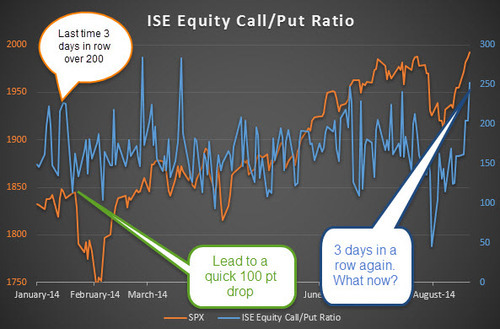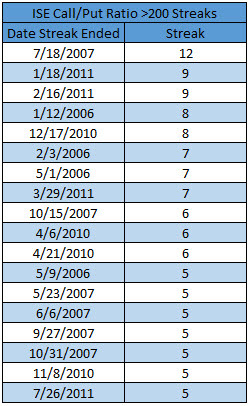Fuente: Ryan Detrick
The ISE Sentiment Index is a proprietary put/call ratio that uses only opening long customer transactions. In other words, it is measuring how many people are buying a new position in bullish call options or bearish put options. I like to use put/call ratios to see if the masses are getting too one-sided. Remember, once everyone is expecting something, it rarely happens when it comes to investing.
This ratio is actually constructed as a call/put ratio and it just had three straight days over 200, meaning there were twice as many calls opened versus puts. Again, when everyone is buying calls (especially on equities like this ratio tracks) that could be a warning traders are a little too excited.
Here’s what really has Twitter buzzing right now. The previous two times we saw three straight days >200 were 1/16/14 and 7/22/11. The S&P 500 (SPX) dropped -3.43% and -10.83% just 10 days later.
Here’s the chart so far YTD. The only meaningful weakness so far this year took place just after the last time this happened. Could a quick drop happen again here?

You have to go back nearly three years for the most recent time other than January we saw three straight days >200. Back in July ‘11 we saw five straight days and this took place just ahead of the huge August correction.

So on the surface this indeed does seem pretty scary. Now I’m not a big fan of just using two data points and saying it matters. It could be random. Going back to 2006 and I found there were 42 other times this ratio was >200 for 3 straight days. Here are the returns after.

My pal @Market_Time created this great chart last night on the subject. It shows all the signals with a chart of the SPX since 2006.

Finally, here are the longest streaks (since 2006) of consecutive trading days with this ratio >200. A few things stand out to me. First off, the longest streak ever took place just a few months before a major market peak. Also there was a streak of six in a row in October ‘07, right as the market peaked. April 2010 saw two streaks of six in a row and this took place just as the market was forming a major peak that took nearly seven months to get back above. Lastly, we simply haven’t seen this phenomena the last few years.

No hay comentarios:
Publicar un comentario